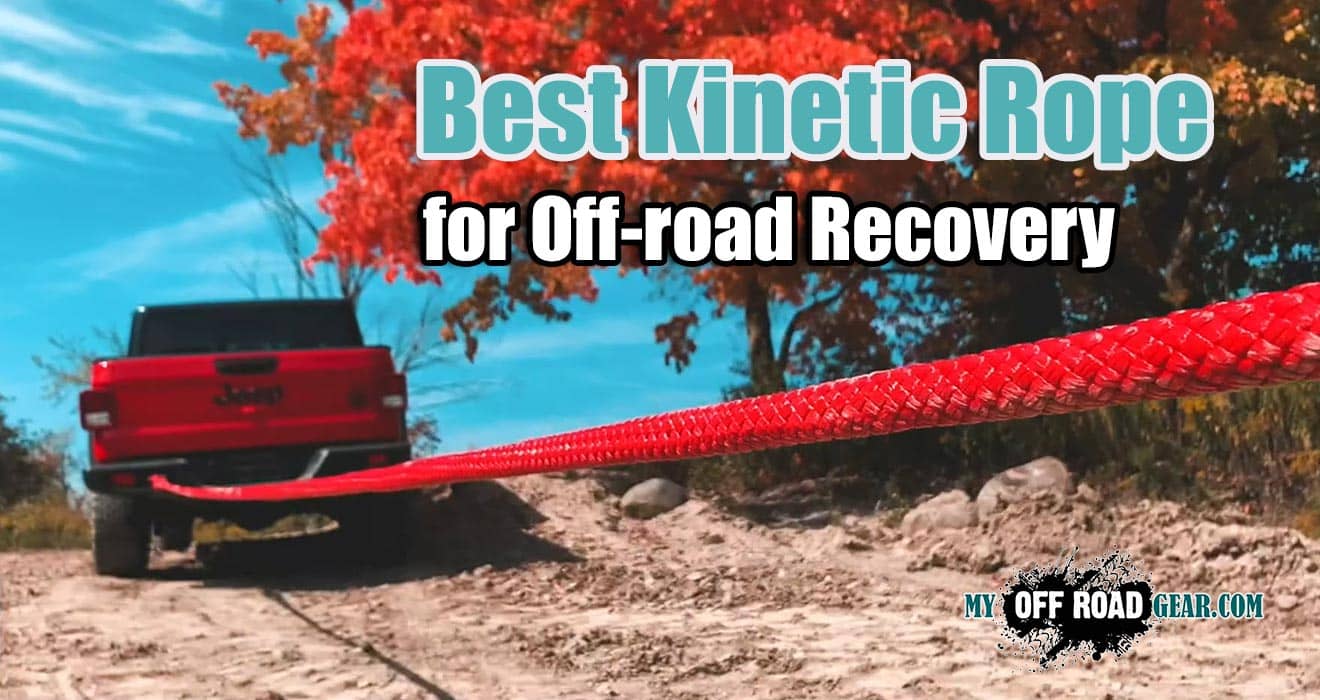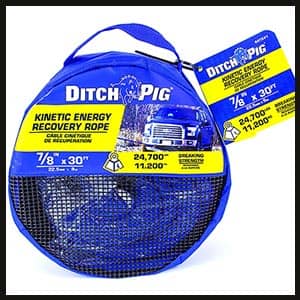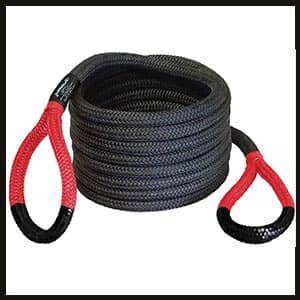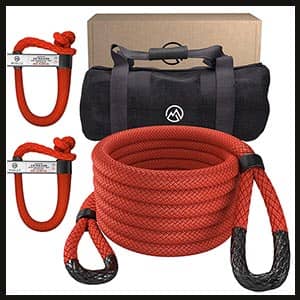Are you searching for the best kinetic energy recovery rope for off-road? If so, then you are at the right place. I have tried many different brands and types of ropes just to find the best one for off-road. In this article, I’m going to review the best kinetic recovery ropes on the market.
Best Kinetic Rope for Off-road Recovery
| Product | Short Description |
|---|---|
|
Expert’s Choice
DitchPig Kinetic Energy Vehicle Recovery Rope |
|
Bubba Rope Power Stretch Recovery Rope |
|
Miolle Kinetic Recovery & Tow Rope |
|
Buyer’s Guide: Choosing the Best Kinetic Energy Recovery Rope
When it comes to off-roading or towing heavy loads, having a reliable and high-quality kinetic energy recovery rope is essential. These ropes are designed to stretch and absorb the energy generated during sudden stops or vehicle recovery, reducing the strain on both the vehicles involved. However, with so many options available in the market, it can be challenging to determine which rope is the best fit for your needs. To help you make an informed decision, here is a buyer’s guide for choosing the best kinetic energy recovery rope:
Strength and Capacity
One of the fundamental and non-negotiable aspects to weigh when choosing a Kinetic Energy Recovery Rope (KERR) is its breaking strength. Breaking strength refers to the maximum load a rope can bear before it fails or breaks. In the context of off-road recoveries, the breaking strength of a KERR is a critical factor that directly correlates with its ability to handle the forces exerted during a recovery operation.
Understanding Breaking Strength
Breaking strength is typically measured in pounds or tons and represents the point at which the rope will fail under a specific load. It serves as a safety margin, ensuring that the rope can withstand the dynamic forces encountered during off-road recoveries without compromising the safety of the recovery operation.
Matching Breaking Strength to Vehicle Weight
The breaking strength of a KERR should surpass the gross vehicle weight (GVW) of the vehicles involved in the recovery. This ensures that the rope can handle the strain imposed by the weight of the vehicles during the recovery process. Selecting a KERR with an adequate breaking strength prevents the risk of the rope snapping or failing under load, reducing the likelihood of accidents or damage to the vehicles.
Consideration for Unforeseen Forces:
Off-road recoveries are unpredictable, and unforeseen forces may come into play. Factors such as sudden jerks, unexpected obstacles, or variations in terrain can subject the recovery rope to dynamic loads beyond the static weight of the vehicles. Choosing a KERR with a breaking strength significantly higher than the GVW acts as a safeguard, accounting for these unpredictable forces and providing an additional layer of security.
Material Influence on Breaking Strength:
The material used in the construction of the KERR directly affects its breaking strength. Different materials, such as nylon and polyester, have distinct tensile strengths and elasticity, influencing how much force the rope can endure before breaking.
Nylon. Nylon is renowned for its high strength and elasticity. KERRs made from nylon often exhibit impressive breaking strengths, making them suitable for a variety of off-road recovery scenarios.
Polyester. Polyester ropes also offer robust breaking strength. While generally slightly less elastic than nylon, they provide durability and reliability in withstanding heavy loads.
Ensuring Compliance with Standards
When evaluating the breaking strength of a KERR, it’s essential to ensure that the rope complies with industry standards and regulations. Reputable manufacturers provide specifications and testing information, allowing consumers to make informed decisions based on accurate breaking strength data.
Choosing the Right Breaking Strength for Your Needs
Recovery Vehicle Weight. Determine the GVW of the heaviest vehicle you plan to recover, and select a KERR with a breaking strength that comfortably exceeds this weight.
Terrain and Recovery Conditions. Consider the specific off-road conditions you anticipate. If recoveries involve challenging terrains, rocky surfaces, or soft soils, a KERR with a higher breaking strength provides an added layer of safety.
Factor in Safety Margin. It’s advisable to factor in a safety margin when choosing a KERR. Opting for a rope with a breaking strength significantly higher than the GVW ensures a robust and secure recovery process.
Breaking strength is a paramount consideration when selecting a Kinetic Energy Recovery Rope. By understanding the weight dynamics of the recovery vehicles, the influence of terrain, and the material-specific breaking strengths, off-road enthusiasts can confidently choose a KERR that aligns with their safety requirements and ensures a reliable and secure recovery experience. Always prioritize safety and adherence to recommended breaking strength guidelines to enhance the effectiveness of your off-road recovery gear.
Rope Length and Diameter
When navigating the world of Kinetic Energy Recovery Ropes (KERRs), two critical factors that significantly influence their performance are length and diameter. These specifications play a crucial role in determining the overall strength, elasticity, and suitability of the rope for various off-road recovery scenarios. Let’s explore the importance of length and diameter when choosing the best KERR for your needs.
Length
Stretch and Elasticity. The length of a KERR directly affects its stretch and elasticity during a recovery operation. Longer ropes generally provide more stretch, allowing the rope to absorb and release kinetic energy more effectively. This elasticity minimizes shock loads on the vehicles involved in the recovery.
Recovery Distance. Consider the typical recovery distances you may encounter. If you often find yourself needing to recover vehicles from a significant distance, a longer KERR is advantageous. This ensures that you have sufficient length to bridge the gap between the recovery vehicles.
Versatility. Longer ropes also offer versatility in various off-road terrains. Whether navigating through mud, sand, or rocky terrain, a longer KERR provides flexibility in adapting to different recovery scenarios.
Compact Storage. While longer ropes offer advantages in certain situations, they should still be manageable for storage. Consider the storage capacity of your off-road vehicle and choose a length that balances versatility with practicality.
Diameter
Strength. The diameter of a KERR directly correlates with its overall strength. Thicker ropes generally have higher breaking strengths, making them suitable for heavier vehicles and more demanding recovery tasks.
Controlled Stretch. Thicker ropes often exhibit controlled stretch characteristics. This can be beneficial in scenarios where a more controlled, less elastic recovery is preferred. It provides stability and predictability during the recovery process.
Weight Handling. Consider the weight of the vehicles you plan to recover. A thicker rope with a higher diameter can handle heavier loads, ensuring that the rope remains within its safe working limits during recoveries.
Terrain Considerations. The diameter of the KERR can also influence its performance in different terrains. Thicker ropes may offer increased durability and resistance to abrasion, making them suitable for rocky terrains or scenarios where the rope may come into contact with rough surfaces.
Choosing the Right Length and Diameter
Assessing Off-Road Conditions. Evaluate the typical off-road conditions you encounter. If recoveries often involve varied terrains and longer distances, a combination of sufficient length and a moderate diameter may be ideal.
Vehicle Weight: Consider the weight of the vehicles you intend to recover. For heavier vehicles, opt for a KERR with a larger diameter to ensure it can handle the load safely.
Balancing Stretch and Control. Strike a balance between the desired stretch and control during recoveries. If you prefer a more controlled recovery, a thicker rope may be suitable.
Storage and Handling. Factor in the practical aspects of storage and handling. Choose a length and diameter that align with the available space in your off-road vehicle and your ability to manage the rope comfortably.
Length and diameter are integral considerations when selecting a Kinetic Energy Recovery Rope. By understanding how these factors influence stretch, strength, and versatility, off-road enthusiasts can make informed choices that align with their specific recovery needs. Whether navigating through challenging terrains or adapting to different recovery distances, the right combination of length and diameter ensures a reliable and effective off-road recovery experience.
Material and Construction
When selecting a Kinetic Energy Recovery Rope (KERR) for your off-road adventures, one of the primary considerations is the material and construction of the rope. The choice of material and the way the rope is constructed significantly impact its strength, durability, and overall performance during vehicle recovery. In this section, we’ll delve into the importance of material and construction when choosing the best KERR.
Material
Nylon:
- Strength and Elasticity:
- Nylon is a popular choice for KERRs due to its exceptional strength and elasticity. This unique combination allows the rope to stretch during recovery, absorbing and releasing kinetic energy efficiently.
- Abrasion Resistance:
- Nylon ropes are known for their resistance to abrasion, ensuring longevity even in rough off-road conditions where the rope might come into contact with rocks, sand, or other abrasive surfaces.
- Versatility:
- Nylon’s versatility makes it suitable for a wide range of off-road recovery scenarios, offering reliability and performance across diverse terrains.
Polyester:
- Durability:
- Polyester is another resilient material often used in KERRs. It provides excellent durability and can withstand the rigors of off-road recoveries, making it a reliable choice for enthusiasts seeking a robust and long-lasting rope.
- Low Stretch:
- Compared to nylon, polyester has lower stretch characteristics. This can be advantageous in specific situations where controlled elongation is preferred.
Construction
Weaving Technique:
- Double-Braided Construction:
- KERRs with double-braided construction are formed by weaving an inner core within an outer layer. This design enhances strength, stability, and overall load-bearing capacity, making it suitable for demanding recovery tasks.
- Single-Braided Construction:
- Single-braided ropes consist of a single layer of fibers intertwined. While these ropes may have slightly less breaking strength compared to double-braided ones, they are often more flexible and easier to handle.
Splicing and Reinforcements:
- Spliced Eyes:
- Many high-quality KERRs feature spliced eyes, where the rope is woven back into itself to create a loop. This construction method provides additional strength at the rope’s attachment points, ensuring secure connections.
- Reinforcements:
- Some KERRs come with reinforced sections at stress points or wear-prone areas. These reinforcements, often in the form of additional layers or protective sleeves, enhance the rope’s durability and resistance to wear and tear.
Considerations for Material and Construction
Terrain-Specific Considerations:
- Rocky Terrain:
- If you frequently navigate rocky terrains, a KERR with strong abrasion resistance, such as nylon, is preferable to withstand the potential friction with rocks and rough surfaces.
- Soft Terrain (e.g., Sand or Mud):
- In softer terrains, where the recovery vehicle may sink, a KERR with sufficient strength and elasticity, like nylon, becomes crucial for efficient recovery without excessive strain on the vehicles involved.
Weight and Handling:
- Lightweight Construction:
- Consider the weight of the rope, especially if you need to carry it as part of your off-road recovery gear. Lightweight constructions, without compromising strength, make handling and storage more convenient.
Brand Reputation:
- Reputable Manufacturers:
- Opt for KERRs from reputable manufacturers known for using high-quality materials and employing advanced construction techniques. This ensures that the rope meets industry standards and is built to withstand the challenges of off-road recoveries.
Abrasion Resistance
Off-road recoveries often involve rough terrains and abrasive surfaces. Therefore, it’s crucial to choose a rope with good abrasion resistance to withstand such conditions without deteriorating. Look for ropes with reinforced eye loops and protective sleeves that minimize wear and tear, prolonging the rope’s lifespan.
Visibility
Opt for a kinetic energy recovery rope with high visibility colors, such as bright orange or neon green. This helps improve safety during recoveries, making it easier for both drivers and bystanders to see the rope and avoid accidents.
Storage and Maintenance
Consider the ease of storage and maintenance for the recovery rope. Some ropes come with a convenient storage bag or case, allowing you to keep the rope neatly organized and protected when not in use. Additionally, check the manufacturer’s instructions for cleaning and maintenance requirements to ensure the rope’s longevity and performance.
Reviews and Recommendations
Before making a final decision, read customer reviews and seek recommendations from experienced off-roaders or towing enthusiasts. Their insights can provide valuable information about the performance, reliability, and durability of different kinetic energy recovery ropes.
Price and Warranty
Finally, consider the price of the recovery rope and compare it to the features and quality it offers. While it’s essential to find a rope that fits your budget, remember that investing in a high-quality rope can save you money in the long run by minimizing the risk of damage or accidents. Additionally, check if the rope comes with a warranty, as it reflects the manufacturer’s confidence in their product.
By considering these factors and conducting thorough research, you’ll be better equipped to select the best kinetic energy recovery rope that meets your specific needs, ensuring safe and successful vehicle recoveries.
The EndLine
If you are getting an off-road vehicle, it is always a good idea to invest in some recovery equipment. Kinetic energy or “kinetic” ropes are known in the market for their strength, reliability and durability. They can withstand the toughest of environments without giving up on you.
The kinetic rope is a useful part of the gear for off-road activities, and it should be in your tool kit. If you decide to carry a rope in your Jeep, it should be at least ten feet long. Ideally, you want a kinetic energy absorbing type. A well-made rope like that can keep people safe even if they go over a cliff or fall on a hard trail.






Add Comment